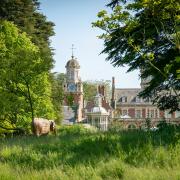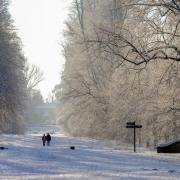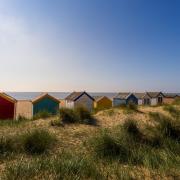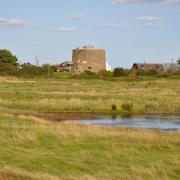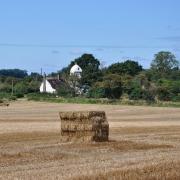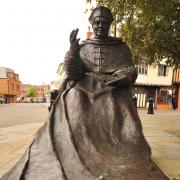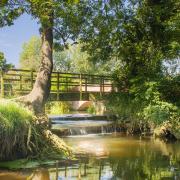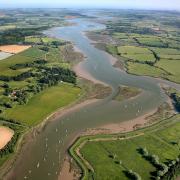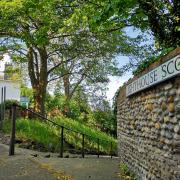Lindsay Want pieces together a river’s history on a marvellous meander of a walk, which both rides the ripples of rolling landscape and simply goes with the flow – the Angles Way between Bungay and Beccles

The truly charming thing about the patch of Waveney Valley between Bungay and Beccles is that nothing is particularly straightforward. Except the B1062 of course. Alas, the Bungay branch line is long-gone. But even if you alight at Beccles train station, with every intention of getting the bus and making a B road bee-line to Bungay Buttercross, for the start of this ‘linear’ walk, you could all too easily find yourself on some unexpectedly winding course and – dare it be suggested – nosing through a whole host of Norfolk villages to reach your destination.
March off along the Angles Way too, across Bungay’s water-meadows towards the Roman military site by Wainford Bridge and, even on a damp day, the assertive way-markers seem to suggest that you’re on the terra firma of an historic route, trodden if not by Romans, then 5th century Angle settlers at least. As time-honoured trails go, the far-from-straightforward, meandering features might raise an eyebrow or two, but does it really matter if the ‘ancient’ trail turns out to be a neatly named, cunning confection and Ramblers’ Association ruse? The motto here has to be, ‘Just go with the flow!’
With one eye always on the weaving path of the Waveney, what the Angle’s Way does so wonderfully well though is join the dots – between ruined castles and long-standing locks, between the Victorian poor-house and historic churches that people now call home, from the heights of Crow’s Nest Wood to the green lane lows of Shipmeadow Marshes or Bungay’s Staithes, and the steep riverside ‘scores’ of Beccles.

Along the way, some stretches have surely felt smugglers’ footsteps by the misty marshes, the weary plod of the ploughboy after a long day in the fields, or the reluctant trudge of a family, heading for the workhouse in times of hardship. Perhaps this was the parson’s path, taken by Lord Nelson’s grandfather during his time as rector of Barsham? Today, it’s romantic enough to will Horatio’s parents-to-be, Reverend Edmund Nelson and Catherine Suckling, into a spot of courting around here before their wedding in Beccles.
The wide Waveney valley is wildlife-rich and silent now, the marsh and river views behind Shipmeadow’s Nunnery Farm, stunning and still. But this part of the Waveney world was all so much busier back then. Stop awhile and who knows what the mind’s eye might see – the rust-brown sails and mast-tips of passing wherries, or impressive trading lighters, navigating their way well past Geldeston locks, with their precious cargos perhaps.
The Walk

1) Today, Bungay seems an unlikely port, but when the Bigods built their castles, the Waveney was a major trade route, even bringing in vines from Burgundy, Champagne and Provence to grace the town’s river slopes. Take a look at the ruins of the last Earl Bigod’s castle before setting off towards Ditchingham from the domed Georgian Buttercross, near St Mary’s Church in the town centre.
2) Walk down through Market Place to Bridge Street, keeping an eye out for devil dog, Black Shuck, chasing his tail on the weathervane – watch it, he’ll be following you on this walk!
Bridge Street is literally steeped in history as it leads down to the Waveney and Chainbridge Beck, with many of the properties once backing on to wharves. Here the days when Bungay folk built great cargo-carrying ‘lighters’ don’t seem so far away. In Victorian times, it was a key commercial area too.

To the right, spot a false window with peephole; list of Bungay Market Tolls; No. 34/ Music House where author-statesman Châteaubriand took refuge during the French Revolution in 1757; a fine, unexpected oriel window, and the smokehouse behind the purple cottage (right).
Take the thoughtful pedestrian part of the bridge across the Waveney as the water-meadows appear. Be brave and venture into Norfolk, accompanied by tales of King Solomon’s Mines written by Ditchingham resident, Sir H. Rider Haggard, and foul play on the village’s former chicken-coup roundabout.
3) After about ¼ mile, turn right through a kissing gate onto meadows (signed Angles Way). Follow the path (converted Maltings on left) through kissing gates into more meadows (football ground and converted Victorian chapel on left), bearing right into a final field (kissing gates on either side and fine view back towards Bungay St Mary’s) to Wainford Road. Turn right to walk carefully along towards the river.

4) Once a Roman military site, today Wainford river crossing is all mills, bridges and ‘Rambling Rector’ roses. The 1670 Act of Parliament introduced locks at Wainford, Ellingham, Shipmeadow and Geldeston, rendering the Waveney navigable once more between Beccles and Bungay. But what was good for moving goods (gentle flow / smooth passage) was less attractive to local millers (fast flow / powerful grinding). No wonder life around here was not all plain-sailing. Continue along Wainford Road to meet the B1062.
5) Turn left at the B1062 to follow way-makers up Watch House Hill a short way to a bridleway (right) between hedges. (Take care by the busy road, but do look back for Bungay and the Waveney Valley views.) Onwards and upwards now, through fields to a little road. Keep right passing a bungalow (left), then as the road bears right, go straight ahead into a green lane eventually to admire views towards Mettingham’s round tower church. Cross another road. Continue along a tree-lined lane to the road near Mettingham Castle.
6) Well, who can resist it? Turn right and soon the north curtain wall appears, adorned with woolly jumpers – nimble lambs who consider the Grade II listed building a climbing frame. A few more steps reward with ruined gatehouse views - alas, little remains of John de Norwich’s fine castle, crenulated in 1342.

A college of secular canons, a farm, a private residence – it gives so little of its history away, yet still says so much about the importance of these lands. Retrace your steps. Regain the Angles Way and pass Crow’s Nest Wood.
7) Where the road turns right, go straight ahead along the signed bridleway. Turn left by a house, around a field until the Angles Way turns left to face the B1026, the Waveney and the old Shipmeadow / Mettingham / Wangford workhouse. Built originally in 1767, it was converted – chapel and all – into dwellings the 1980s. ‘Viewpoint Mews’ looks comfortable enough these days, but stop by Beccles Museum later and its earlier furnishings tell a different story. Where the path meets the B0162, turn right.
8) Nothing in Shipmeadow is quite what it seems. St Bartholomew’s Church, declared redundant in 1980, has a letterbox and coat pegs in its porch and play equipment in the graveyard.

The village sign by Low Road, sits on a fence of sorts, showing those woolly jumpers sheltering by the mast and sails of some great lighter – or is it a wonky tent? Nearby Nunnery Farm welcomes campers – take a closer look as you follow the Angles Way signs left, through the farm’s gateway past the Monkeypuzzle tree, to a stile at the bottom of the garden!
Waveney Valley views stretch out ahead as the path leads along a field. Ignore the next stile (left), instead head right across a field to a footbridge and over a stile into a green lane alongside the marshes. Go straight on through a gate and past a cottage (left), keeping left onto the ‘Locks Lane’ track. Near the pumping station, it’s decision time…
9) Feeling thirsty? Or fancy resting those limbs and letting the Waveney and a big dog carry you the last leg to Beccles? Take the footpath left across the meadows, over a footbridge, then the river bridge to Geldeston Locks Inn.
The riverside retreat recalls the days when the landlord ran lock, navigation plus pub on the busy trade route. Plenty of spectres of the past here - stories of smugglers, ghosts, illegal prize-fighting and the potty East Anglian sport of dwile-flonking!
The Big Dog Ferry runs regular transfers from here to the Beccles Lido quayside (just below the museum) – a great way to experience the Waveney from a different angle. Prefer to stay on track? Follow the footpath as it curls right, rejoining the Angles Way, edging woods and fields to reach...
10) The most enormous stile imaginable. Seriously, you might need a leg up - it dwarfs anyone under 6 foot! Go along the fenced path between field and wild cherry woodland to the track which leads up to Holy Trinity Church and the 1970s fayre grounds of Barsham or down to the remains of Barsham Hall. Cross the track, carrying on past a drainage dyke, enjoying views of Barsham church and the Waveney. Finally, the Angles Way bears right and widens, leading up to the B0162 once more just before secretive and highly haunted Roos Hall.
11) Turn left, along the grass verge opposite Barsham Rigg, past Roos Hall (left). Drop down left into Puddingmoor. Here Cliff House Steps lead up to Beccles Museum with its secret garden views out across the Waveney (12), the town’s great 16th-century belfry (13) and over to the station (14).
______________________________________




